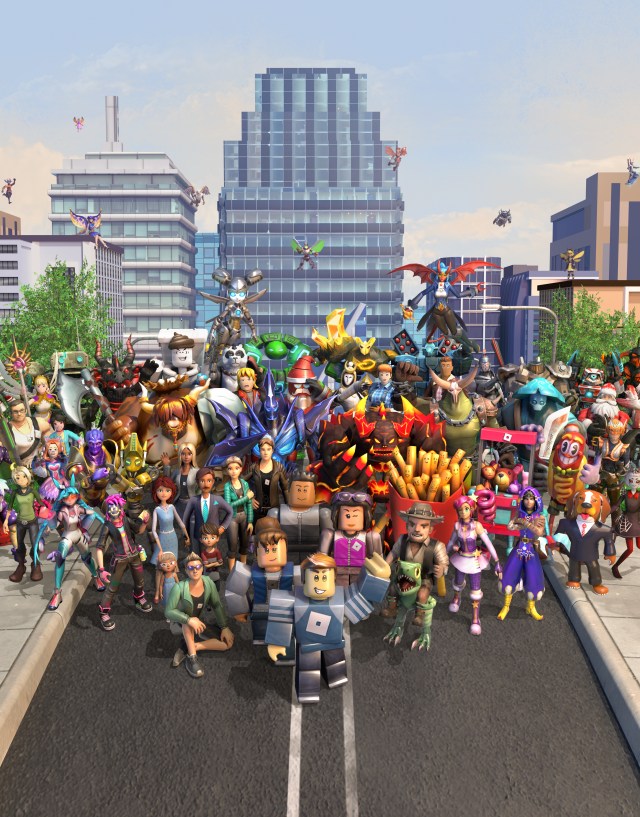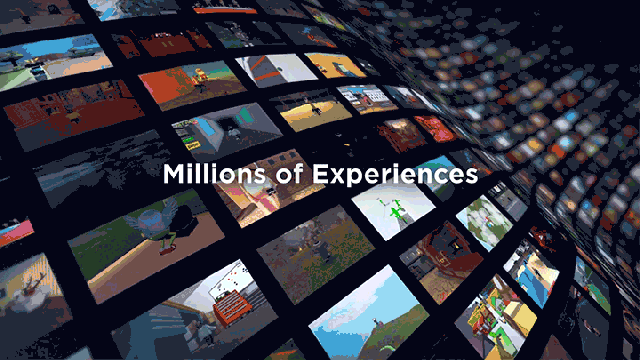If you’re a parent with a gaming kid under the age of 16, chances are good that you’re already familiar with Roblox, the hugely popular multiplayer online gaming platform that seemingly came out of nowhere to capture the attention (and obsession) of kids all across the globe.
While you also may know about Robux, Roblox’s in-game virtual currency, which consistently ranks among the most-requested gaming gift cards for kids, you may not be aware of many other details about the game itself and have lots of questions about safety, security and excessive screen time related to Roblox gameplay.
Worry no more: Our guide to Roblox for kids will hopefully answer many of the questions that you might have but are too afraid to ask! Read on to learn more about the seemingly ubiquitous gaming phenomenon.

What Exactly Is Roblox?
Simply put, Roblox is a persistent (meaning, it’s online all of the time, 24/7), multiplayer gaming platform that lets millions of users around the world create, share and play 3-D games and virtual experiences with one another—all in real-time.
Roblox can be played on a variety of devices and operating systems, ranging from smartphones and tablets to laptops and gaming consoles—even VR headsets. Because of Roblox’s wide accessibility, relative ease of gameplay and freemium cost model, young gamers (especially those under age 13) have latched on and propelled its popularity in recent years, making it the most popular entertainment app for that age group.
After creating and logging into free-to-play (more on costs later) personalized accounts, players choose from more than 40 million games and experiences, in which they virtually interact with other players using customizable avatars, audio chat or text chat.
Many games are freeform and immersive explorations in virtual environments. Some popular ones focus on building homes and tending to pets and babies, while others are more action-oriented, including first-person shooter and racing games. Ranked by the number of visits, Adopt Me!, where players—you guessed it—adopt, raise and collect various pets, is currently number one. Other top entries include Tower of Hell, MeepCity and Brookhaven.

What Do Players See and Do on Roblox?
Through their customizable avatars, Roblox players are immersed in colorful and dynamic virtual 3-D worlds and experiences that they can explore and move through via touch screens, gaming controllers or keyboard strokes and mouse clicks—much like any other video game.
As a platform to reach consumers, Roblox has become a big business: Major brands, such as Gucci, have partnered with Roblox to create virtual boutiques that sell exclusive virtual merchandise for avatars, like sunglasses and beanies. Meanwhile, musicians such as Lil Nas X and Twenty One Pilots have hosted virtual concerts that have attracted millions of viewers.
While some parents may find navigating Roblox’s game interface confusing, most kids will find controlling and customizing their avatars to be fairly intuitive. Experts say the concept of crafting a virtual character and interacting using avatars in virtual spaces—what’s been coined as playing in the Metaverse—“is not novel to kids that are playing Roblox because they grew up in the metaverse, that’s all they know,” says Colin Rosenblum, a tech writer and YouTuber who covers content creators with Samir Chaudry on the Colin and Samir YouTube Channel.
What sets Roblox apart from other digital video games—such as Minecraft or Fortnite, for example—is the unique creator system that’s built into its gameplay. The vast majority of content and games available on Roblox are user-created and supported, versus created and developed by professional gaming studios. By comparison, while most other digital video games have prescribed rules for playing and specific pathways to winning, Roblox’s gameplay is fluid and collaborative by design. Social interactivity is essential to Roblox’s gameplay and popularity.
“Roblox games reflect the sort of imaginative play you often find in the playground,” says Andy Robertson, a U.K.-based family technology expert, author of Taming Gaming and creator of the Family Gaming Database. “One child has an idea about a game to play, others join him or her, and the rules slowly change as the group decides how to have fun together. Roblox creators can quickly update and adjust their games to match the demands of the huge playing community.”

When Did Roblox-Mania Begin?
Despite parents noticing Roblox-mania among their kids and their kids’ peers only over the past few years, Roblox has been around for nearly two decades. An early iteration of the game was first introduced in 2004 by San Mateo, CA-based game developers David Baszucki and Erik Cassel, followed by the 2006 release of Roblox’s online gaming platform and game creation system.
Today, Baszucki is CEO of Roblox Corporation, the parent company of Roblox, and his username, “builderman,” is still the first welcome message that new players receive when they register new accounts.
Although Roblox’s popularity grew steadily in the 2010s, the 2020 COVID-19 pandemic and subsequent lockdown helped to further accelerate Roblox’s popularity, especially among younger gamers. By 2021, Roblox achieved a milestone of 202 million monthly active users globally, an increase from 146 million in the previous year. Today, Roblox has more than 43 million daily active users, with a whopping 67% of Roblox users under age 16.
Many parents have stories of how when their kids were attending remote school and unable to have in-person playdates, Roblox was a lifeline between their kids and their friends. For many, meeting and playing together in Roblox’s virtual environment became a welcomed antidote to social distancing rules for both kids and parents alike.
“[During lockdown] my sons would set up playdates with their friends and say, ‘we’ll meet you in a specific game on Roblox,’ ” says Angeline Yeo, a Bay Area mom of 11-year-old twin boys Reece and Logan, who both started playing Roblox about a year ago. “It was the only way for them to connect with friends because San Francisco was pretty locked down then.”
As word of mouth among elementary school gamers spreads, Roblox continues to amass more players, who spend an average of 2.6 hours per day on the platform.

Roblox for Kids: Is It Safe?
Entertainment Software Ratings Board (ESRB), the non-profit, self-regulatory body for the video game industry, gives Roblox an ESRB rating of E10+, meaning it’s suitable for all players ages 10 and older, although it’s a game that’s popular with even younger players. Consequently, Roblox’s strict Community Standards focus on fostering a safe and secure environment for players of all ages.
Roblox has a zero-tolerance policy when it comes to child endangerment, violence, bullying and harassment, among other key safety tenets. The platform utilizes both software and 1,600 human moderators to filter and block inappropriate content, but offensive communications or inappropriate user-generated content can sometimes slip through the cracks.
“It’s important for parents to familiarize themselves with the robust parental controls that Roblox provides to ensure their children are shielded from inappropriate content or communications,” says Patricia Vance, president of the ESRB.
First and foremost, Vance insists that parents make sure their kid’s Roblox account is registered with an accurate birthdate, which enables automatic filtering and other protections that are designed to safeguard children under age 13. Additionally, kids and parents alike should familiarize themselves with how to block and report bullying or disruptive players. Last and most importantly, parents should teach their children never to share personal information online, including real names, addresses or passwords.
“Roblox’s parental controls give parents the ability to curate the content their kids may encounter when playing, including options to restrict voice chat only to approved friends or turn it off entirely, create a white list of age-appropriate games for your kids, and more,” Vance says.
Start here to find out how to activate Roblox’s safety tools.
Is Roblox Free to Play?
While Roblox is ostensibly free-to-play, there are plenty of in-game purchases. Many Roblox players say gameplay is hindered by not making in-game purchases, which include buying everything from virtual gear and clothing for avatars to virtual food to feed pets to virtual furniture as well as the ability to unlock levels and skills.
Roblox’s in-game virtual currency is called Robux and it costs real dollars to acquire. The more real money spent, the better the exchange rate: For example, 800 Robux cost $10, 4,500 Robux cost $50 and 10,000 Robux cost $100. There also are three tiers of Roblox Premium memberships, which have recurring monthly charges.
Parents with Roblox players are all too familiar with requests for more Robux, which can easily get out of hand. Yeo has a simple solution: “I don’t give the boys money [for Robux]; they are responsible for funding their own Robux through birthday money and red envelope cash gifts.”
How to Manage Screen Time?
Increasing screen time for kids is an ongoing concern for many parents, especially when kids already spend so much time on screens at school and at play. The American Academy of Pediatrics discourages media use by children younger than age two and recommends limiting older children’s screen time to no more than one or two hours a day.
But managing screen time for kids is often easier said than done, especially when online games like Roblox can easily become addictive. The Mayo Clinic offers three simple suggestions for helping to reduce screen time for kids:
- Eliminate background TV
- Keep TVs, smartphones and computers out of bedrooms
- Don’t eat in front of screens.
When kids are using screens, experts encourage parents to be proactive about monitoring what, when and how much media they consume. When it comes to gaming, it’s easy to lose track of time, so parents of gaming kids should be especially vigilant, experts say.
“Kids have become so accustomed to screens,” says Mike Chung, a Redondo Beach, Calif.-based marketing technology strategist whose six-year-old son Teddy recently started dipping his toes into Roblox. Chung says Teddy’s access to apps on his iPad currently is limited to YouTube Kids, Khan Academy, Roblox and a few other pre-approved gaming apps. And while it’s easy to manage his son’s screen time at this age (“he’s six, as parents, we can just turn off his iPad”), Chung recognizes that managing screen time for kids will get more difficult as they grow older.
The good news for parents is that Roblox provides numerous settings to help moderate young gamers’ activities on the platform, including restrictions on how much time and money your child can spend. Parents also should take advantage of parental monitoring tools such as Microsoft’s Family Settings, Apple’s Screen Time and Google’s Family Link to manage precisely when and for how long your child is permitted to play games.
Still, many parents continue to be concerned about the excessive amount of time their kids are spending online playing games like Roblox. While these concerns are warranted, there is growing evidence that supports the creative and social value of playing video games.
“The social benefits of playing video games, both off- and online, have been grossly under-addressed in the media,” says Dr. Rachel Kowert, a research psychologist and the research director of Take This, a non-profit mental health organization that supports the diverse cultures and issues of the gaming community. “Rather than video games having created a generation of addicted and antisocial youths (as the stereotype would suggest), research indicates that the highly social nature of video games, both off- and online, helps to build and maintain friendships, both with pre-existing ‘offline’ friends and online friends.”
As one parent put it, there are pros and cons to Roblox for kids:
On the con side, some games on Roblox can be violent, and some bad players may want to take advantage of kids through scams or inappropriate conversations. Parents must be vigilant and proactive about implementing Roblox’s numerous age-appropriate safety and security tools.
On the pro side, the creative aspects of Roblox gameplay can spark a child’s imagination and further her interests in design and building. Plus, staying in touch with friends and family virtually when they’re unable to be together in person is a bonus.
RELATED STORIES:
The Latest Roblox Collab Is All About Less Screen Time
Can Video Games Help a Child’s Learning & Development?
11 Video Games You Can Play with Your Kids (That Are Fun)











